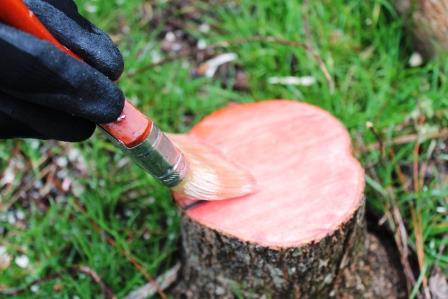
by Mark Mauldin | Feb 20, 2014
As Floridians we often struggle to find any upside to these cold, gray days we’ve been experiencing past few months. As “unfloridian” as our winters can be they pale in comparison to those endured by the more northern states. In fact, the last days of winter can be the ideal time of year in the Panhandle to tackle some outdoor chores like controlling unwanted trees and other woody plants.
Controlling trees can be hard work, the cooler temperatures can make the task a little less taxing. The relative inactivity of the “creepy crawlies” and pests often found in wooded areas is another reason to consider completing tree and woody plant removal projects during the winter.
Tree control generally involves mechanical removal. In some cases mechanical removal provides only short term control; in other cases it can actually increase the number of unwanted plants over time. This is the problem with both Chinese tallow (popcorn tree) and privet. Herbicide treatments can eliminate the possibility of regrowth and provide permanent control. The herbicide application techniques used to control trees and other woody plants are very selective and they are effective during the winter. These techniques provide opportunities to use herbicides in a controlled and very targeted manner with very little risk to surrounding plants. Additionally, the techniques below are most effective through the fall and winter when sap flow in trees is lessened.
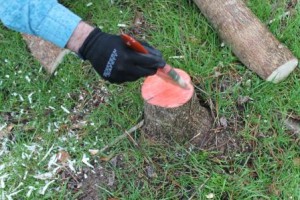
For best results the cut stump treatment should be done immediately after the tree has been cut down. Photo courtesy of Mark Mauldin.
The cut stump technique is a fairly common and very effective method of achieving permanent control of woody plants. As the name implies, the first step in the cut stump technique is to cut down the tree. Immediately after cutting down the tree spray or paint the stump with herbicide. On smaller stumps the entire surface should be covered with herbicide; on larger stumps effective control can be achieved by only covering the outside three inches of the stump.
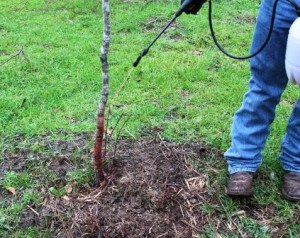
With the basal treatment, cover the bottom 12 to 18 inches of the tree with the herbicide oil mixture. Be sure to cover the entire circumference of the tree. Photo courtesy of Mark Mauldin.
Two additional herbicide application techniques that work well on woody plants do not require the plants to be cut down first. The basal application technique works best on smooth barked woody plants with a diameter of less than six inches. This technique involves spraying the bottom 12 to 18 inches of the tree with an herbicide oil mixture.
The hack and squirt method works well on large and/or thick barked trees. This technique involves using hatchet or other tool to cut through the bark around the circumference of the tree, then applying herbicide directly to the cut. Several months should pass between herbicide application using either of these techniques and mechanical removal.
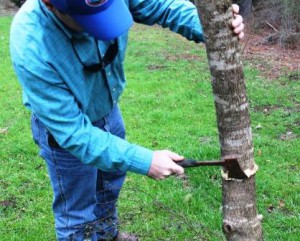
The hack and squirt treatment is best for large and/or thick barked trees. Photo courtesy of Mark Mauldin.
Be sure to read and follow the label of any herbicide you use. Always wear the proper personal protective equipment. For more information on the techniques described, including recommended herbicides and rates, read Herbicide Application Techniques for Woody Plant Control or contact your county’s UF/IFAS Extension Office.
by Brooke Saari | Feb 8, 2014
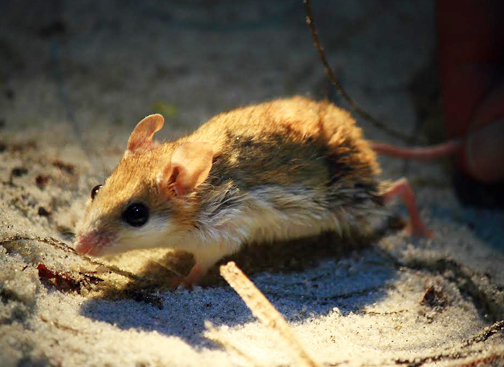
The Choctawhatchee Beach Mouse is one of four Florida Panhandle subspecies classified as endangered or threatened. Beach mice provide important ecological roles promoting the health of our coastal dunes and beaches. Photo provided by Jeff Talbert
Sea Turtles are one of the largest and most beloved animals associated with Florida coastal habitats. However, there is a tiny creature that depends on the coastal dune system that few get a chance to see, the beach mouse. As the name implies, beach mice make their home on beaches and in nearby dunes. These mice are a subspecies of the oldfield mouse. There are eight subspecies, five on the Gulf Coast, two on the Atlantic, and one extinct species.
The Florida Panhandle has four beach mouse subspecies: (in order from East to West) St. Andrew beach mouse, Choctawhatchee beach mouse, Santa Rosa beach mouse, and the Perdido Key beach mouse. Beach mice utilize the primary and secondary dunes for food, water, cover, and raising young. They have many burrows throughout the dunes and forage on seeds, fruits of beach plants, and insects. Beach mice are most active during the night and considered to be nocturnal. Under the cover of darkness, they make several trips in and out of their burrows to find and cache food. Feeding activities of beach mice disperse seeds and plants, adding to the health of the dune ecosystem.
Worldwide, the biggest threat to ecosystem biodiversity is habitat loss and fragmentation. Since beach mice are dependent on one specific type of habitat, it makes them susceptible to natural and human created disturbances. Due to loss of their primary and secondary dune habitats, all the beach mice except for one are classified threatened or endangered. The Santa Rosa beach mouse is the only subspecies that is not listed as threatened or endangered due to most of their habitat being protected within conservation lands on Santa Rosa Island.
Beach mice populations are continually monitored to track movement, growth, and reproduction. The common method for population counts is through the use of traps and track tubes that record mice tracks. Track indices have been developed to estimate mouse abundance.
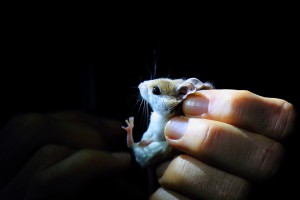
Choctawhatchee Beach Mouse photographed during research effort in South Walton County. Photo by Jeff Talbert
A collaboration of three state agencies just concluded a five day population study of the Choctawhatchee beach mouse in south Walton County. The purpose of this effort was to study the movement in heavily (beach mice) populated areas and the effects of non-native predators on those populations. Predators specifically studied were feral cats, foxes, and coyotes. The study also evaluated the 2011 re-introduction of 50 beach mice, from the Topsail Hill Preserve State Park population into the Grayton Beach State Park population. Reintroduction was done to boost numbers of the mice in that area and expand the gene pool for the subspecies.
The data from the current effort is still being analyzed but positive results are expected due to healthy beach mice being found in areas of focus and some new areas. Public lands such as parks and wildlife refuges are important for the preservation of beach mice as well as other coastal dune species that utilize similar habitats. It is important that awareness be shared on these and other species to help these efforts to keep our habitats safe and healthy.
For more information on marine science and natural resources information, email or call bsaari@ufl.edu or 850-689-5850.
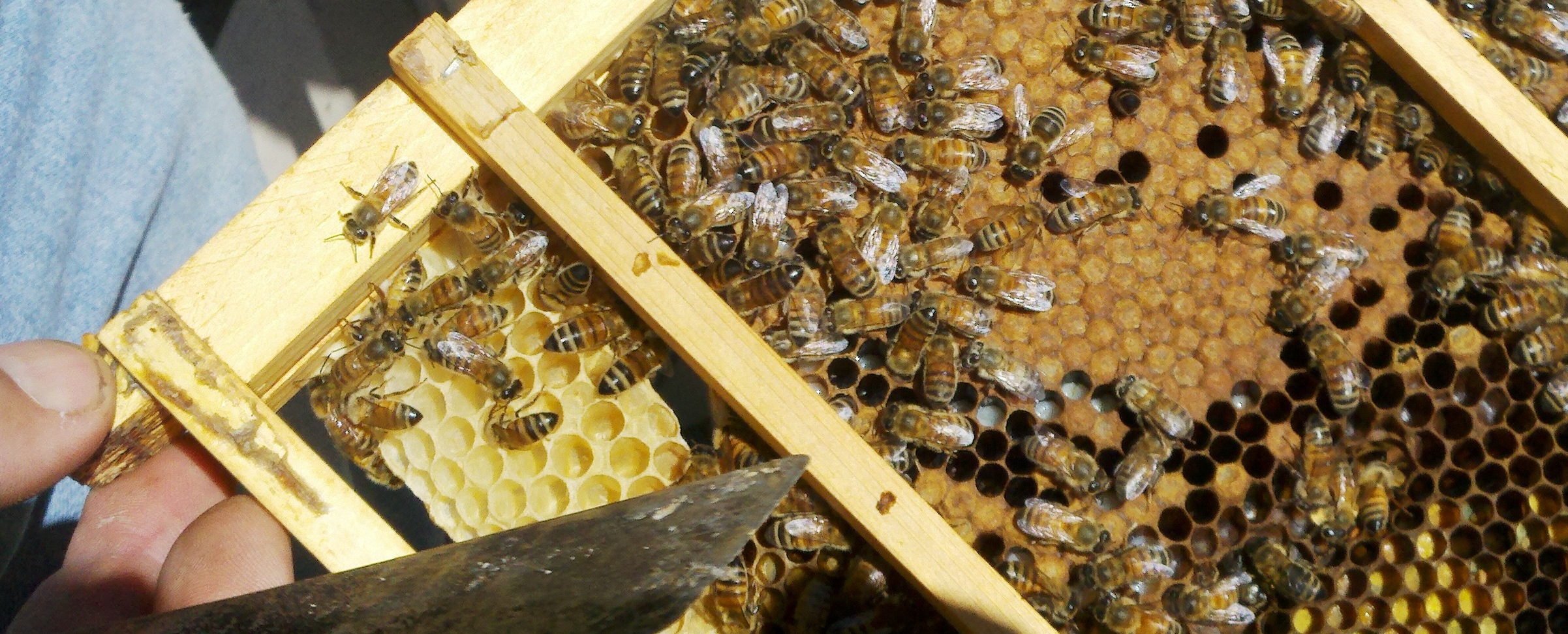
by Judy Biss | Feb 7, 2014

Photo by Judy Ludlow
The UF/IFAS Panhandle Agriculture Extension Team will once again be offering a Basic Beekeeping School in February and March. These classes will be offered via interactive video conferencing at Extension Offices across the Panhandle. Details are listed below, please call your local UF/IFAS Extension Service to register and if you have any questions. See you there!
- These classes will be taught by Dr. Jamie Ellis and other state and nationally recognized beekeeping experts from the University of Florida Honey Bee Research and Extension Lab and the Florida Department of Agriculture & Consumer Services Bureau of Plant and Apiary Inspection.
- There will be three Monday-evening and one Tuesday evening interactive video conferences from 6:00 – 8:00 pm Central time, (7-9 pm Eastern time) and a Saturday bee-yard field day.
- Each 30-50 minute presentation will be followed by a question/answer period
February 24: Honey Bee Biology and Anatomy
March 3: Varroa Mite Biology and Control
March 10: Honey Bees of the World and Beekeeping History
March 15: Bee-Yard Field-Day – A hands on teaching opportunity
March 18: Yearly Management of the honey bee
- The cost for all five classes is $25 per person or $40 for a family. This fee will cover course materials and refreshments.
- Deadline to register is February 17, 2014. Please contact your local UF IFAS Extension office to register or to find out more details, or click on the following link for a printer-friendly flyer: 2014 Beekeeping in Panhandle
Bay County 850-784-6105
Calhoun County 850-674-8323
Escambia County 850-475-5230
Franklin County 850-653-9337
Gadsden County 850-875-7255
Gulf County 850-639-3200
Holmes County 850-547-1108
Jackson County 850-482-9620
Jefferson County 850-342-0187
Leon County 850-606-5202
Liberty County 850-643-2229
Okaloosa County 850-689-5850
Santa Rosa County 850-623-3868
Wakulla County 850-926-3931
Walton County 850-892-8172
Washington County 850-638-6180
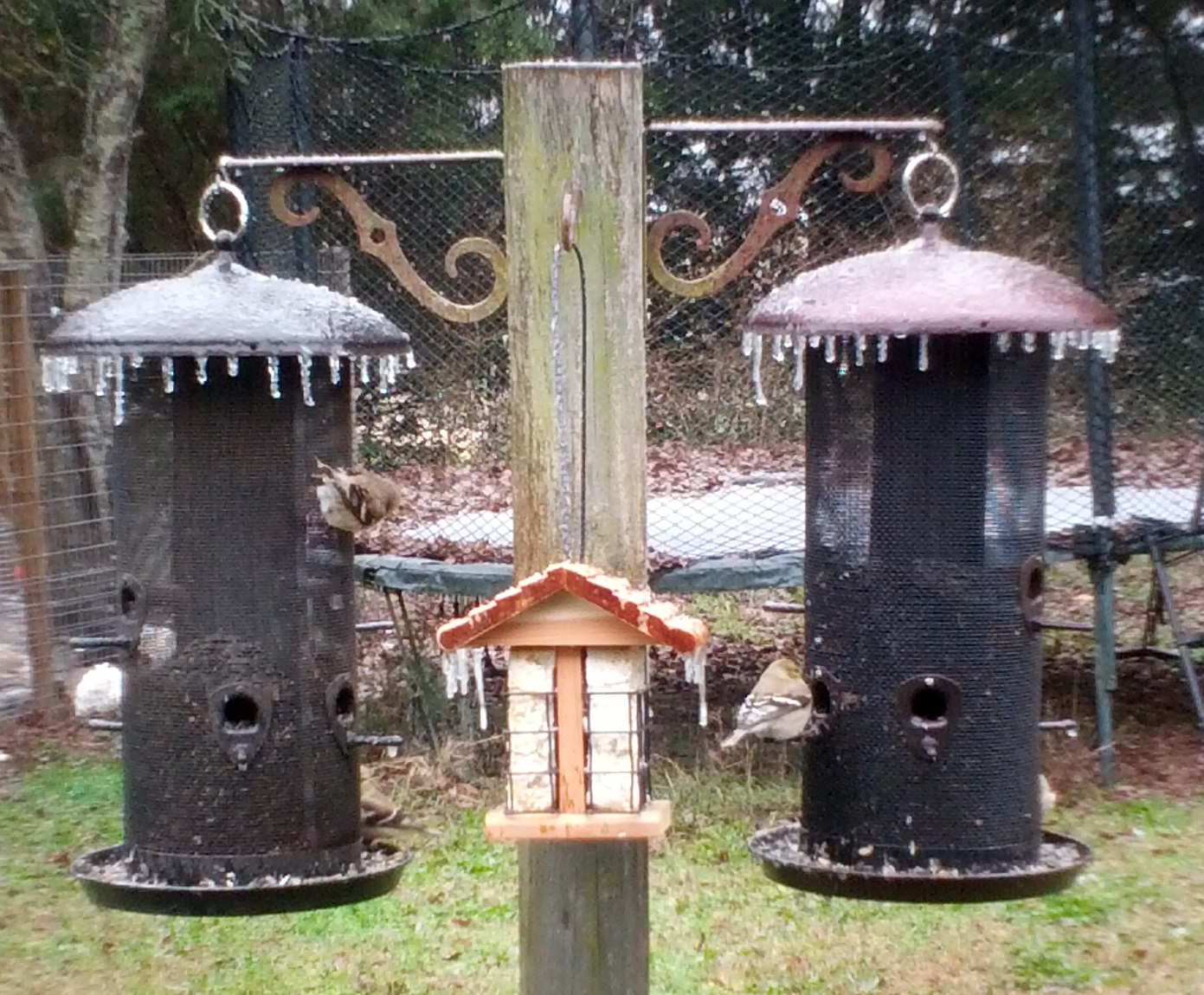
by Judy Biss | Feb 2, 2014

Even though adapted to weather extremes, these migratory American goldfinches (Spinus tristis) appreciated the food and cover provided in this backyard. Photo by Judy Ludlow
North Florida experienced a weather delight (or distress depending on your point of view!) this week in the form of freezing rain and snow! The words “Florida” and “snow” are two words most people would not place together in the same sentence, but you may be surprised to learn that snow has been documented a number of times in Florida as revealed by records as early as 1891. In Tallahassee, measurable snow has not fallen since 1989.
The following information is taken from the National Weather Service Weather Forecast Office Tallahassee, FL about the history of Snowfall in Tallahassee: Several winters ago, NWS Tallahassee Climate Focal Point, Tim Barry, responded to an inquiry from a reporter concerning snow climatology in Tallahassee. Some of those questions and answers are listed below.
In ten-year intervals, how many times has it snowed in Tallahassee Florida?
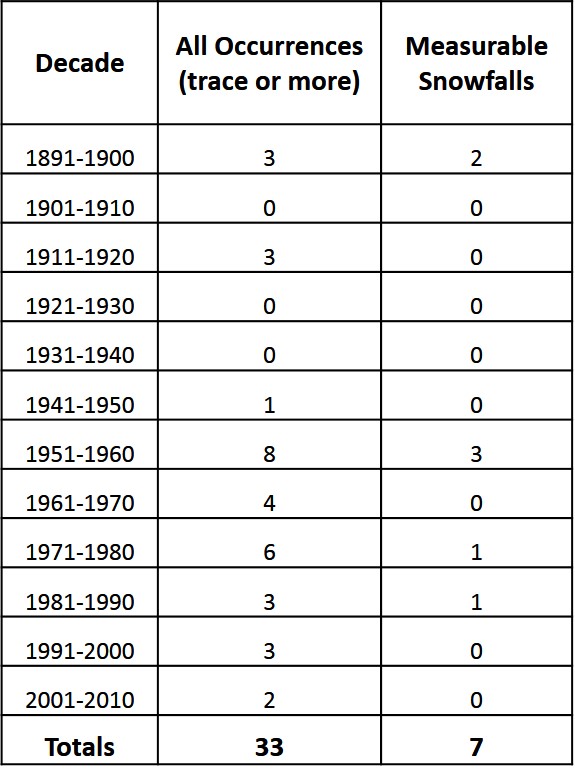 How frequently does Tallahassee see snowfall?
How frequently does Tallahassee see snowfall?
From the information provided in the 1st question, we see that it snowed 32 times in Tallahassee since 1891. Please note that all but 7 of these occurrences were only Trace amounts. If we were to divide the period of record (117 years) by 32 we would get a frequency of once every 3.66 years. But as you can see from above, the more frequent occurrences of snow in the 50’s ,60’s and 70’s have skewed the results. The return period for measurable snow is just once every 17 years. The most snow recorded in a 24-hour period was 2.8″ from February 12th – 13th, 1958.
Any interesting or exciting facts about Tallahassee winters?
There is a significant difference between the climate of north Florida and the southern portions of the peninsula. On average, we experience 35 days with minimum temperatures at or below freezing with most of these occurring from December through March. The coldest temperature ever recorded in Tallahassee was -2 F on February 13th 1899. More recently, we dipped down to 6 degrees F on January 21st, 1985.
Florida’s wildlife, although adapted to Florida’s weather, will thrive given the added boost of backyard habitats planned for their benefit, especially during these winter weather extremes! During the winter, Florida’s native, resident, wildlife species are also joined by species which are here temporarily as they migrate through our state. The hundreds of American goldfinches (Spinus tristis) outside my window are one example.
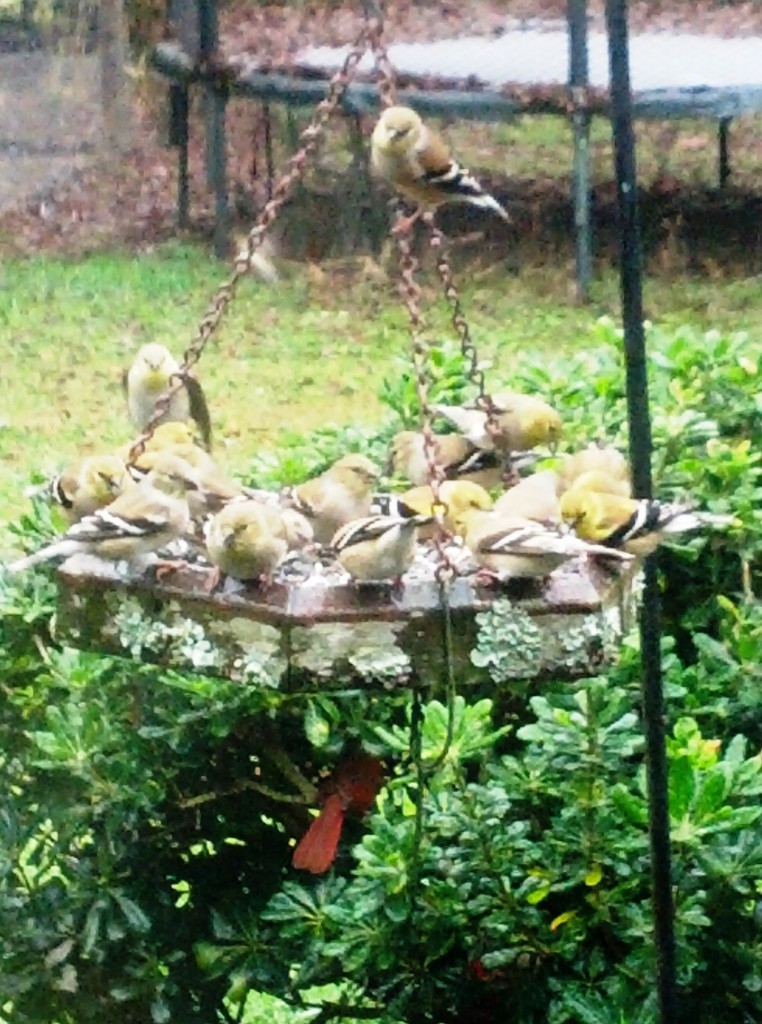
Do you see the red cardinal in the shrub? A variety of cover strategically placed near food sources helps minimize predation and provides protection from weather extremes. Photo by Judy Ludlow
When growing your backyard habitat, think about recreating features which are naturally provided in undisturbed habitats, but only on a smaller scale. To flourish, wildlife need adequate nutritious foods, functional cover, and clean water. Locating food close to cover minimizes the exposure of foraging wildlife to severe weather conditions and to predation; these two factors account for a large percentage of mortality. Cover comes in the form of trees, shrubs, brush piles, etc. of varying heights and sizes.
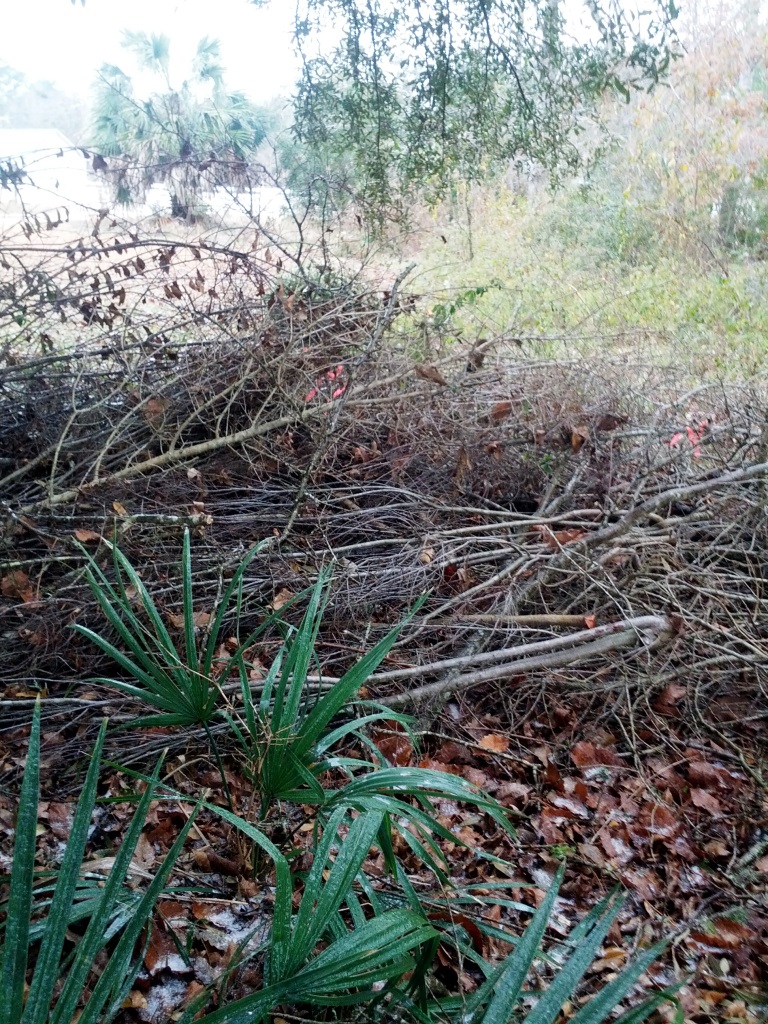
Brush piles such as this one provide valuable wildlife habitat for many species. Photo by Judy Ludlow
The following information is from the Florida Fish and Wildlife Conservation Commission’s publication: Planting a Refuge for Wildlife.
Cover: Breeding, nesting, hiding, sleeping, feeding and traveling are just a few of the necessary functions in an animal’s life which require protective cover or shelter. Often plants used for cover double as food sources. Strategic placement of cover is very important in that it reduces exposure to weather extremes and provides escape from predators.
Food: All animals get their energy for survival from plants or other animals. The ideal wildlife management plan uses natural vegetation to supply year-round food – from the earliest summer berries to fruits that persist through winter and spring (such as sweetgum, juniper and holly). You will attract the widest variety of wildlife to your land by using native plants to simulate small areas of nearby habitat types. The “edges” where these habitat types meet will probably be the most visited areas in your neighborhood.
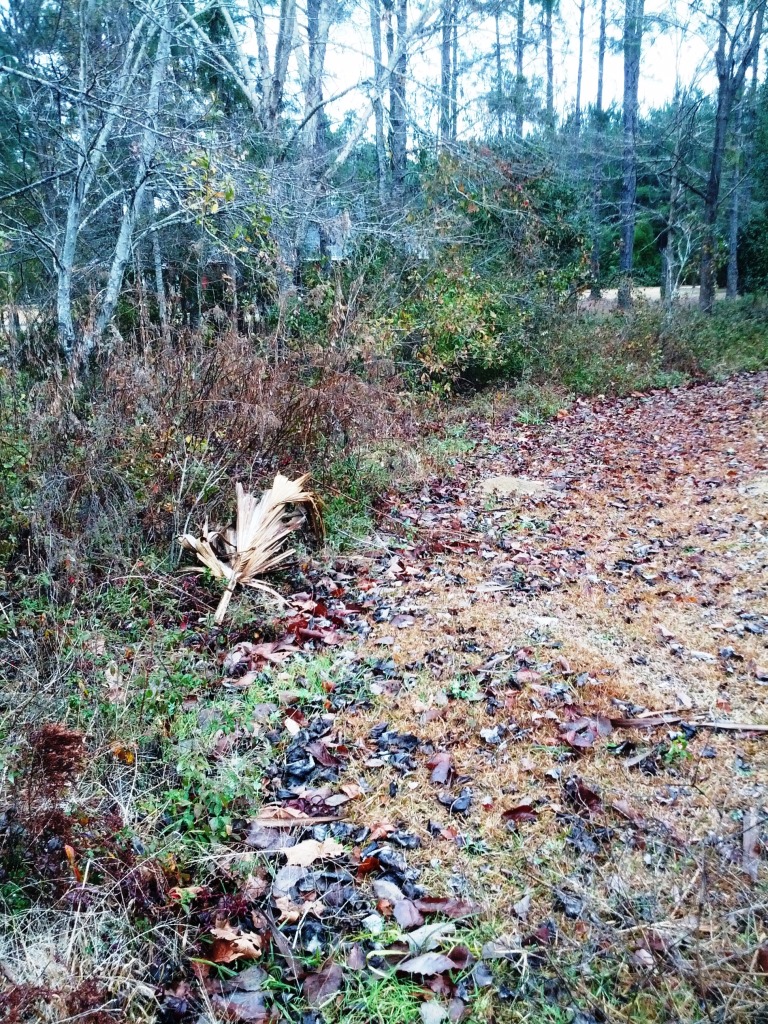
The boundary between two habitats such as between this lawn and small wooded area, creates an “edge effect” which is important to wildlife. Photo by Judy Ludlow
If you are interested in learning more about this topic, please read the following publications and, as always, please contact your local UF/IFAS Extension Agent if you have any questions.
Planting a Refuge for Wildlife
Landscaping for Wildlife
A Drop to Drink
Eight Ways to Double the Bird Species at Your Feeders
Landscaping for a Song
Making Your Backyard a Way Station for Migrants
On Your Own Turf
Plant Berry Producing Shrubs & Trees
Plant Wax Myrtles
There’s Life in Dead Trees
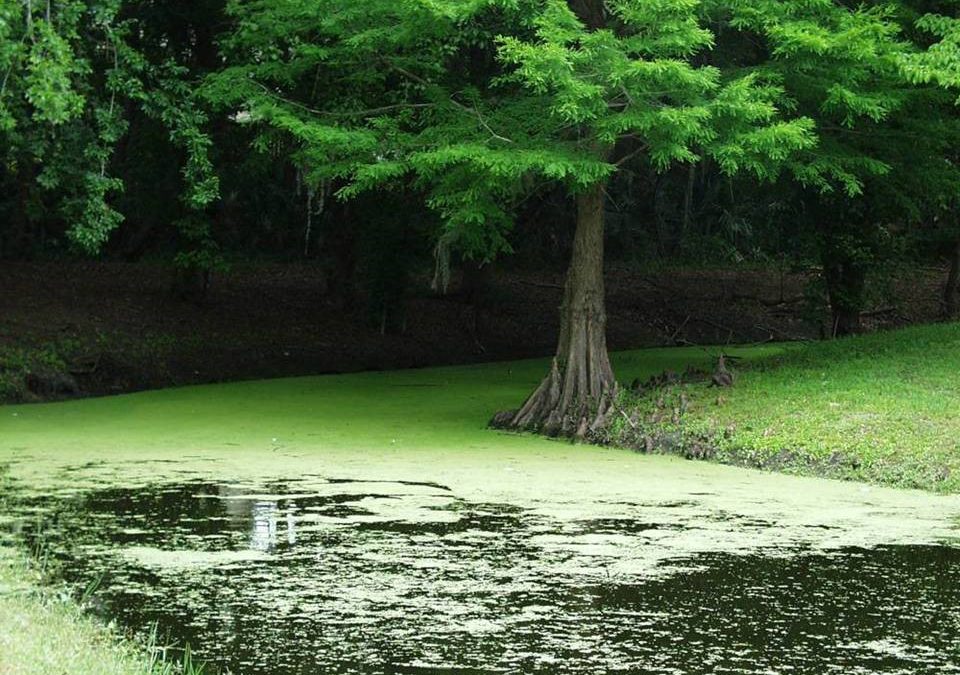
by Carrie Stevenson | Jan 11, 2014
Beginning New Year’s Day of 2014, a new law went into effect that state lawmakers, environmental advocates, and lawn care professionals hope will reduce Florida’s decades-long problem with stormwater runoff pollution. The law states that all lawn care professionals applying fertilizer as part of their business must pass a Green Industries Best Management Practices (GI-BMP) test and receive a certification commonly referred to as a “fertilizer license.” The Florida Departments of Agriculture and Consumer Services and Environmental Protection maintain the records and regulatory authority over these licenses.
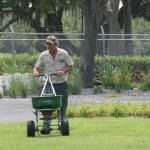
Lawn care service providers applying fertilizer to Florida landscapes are now required to complete best management training. Photo credit: UF IFAS
Fertilizer becomes a problem in the environment when either too much is applied or it is used at the incorrect rate or wrong time. Rain or irrigation water can move these nutrients (remember, fertilizer is mostly composed of nitrogen, potassium, and phosphorus) off target, leaching them into the soil and groundwater or running off into surface waters.
Once in a creek, lake, river, or bay, this fertilizer intended to improve growth of turf or landscape plants instead fuels the growth of algae. In certain conditions this causes eutrophication, an overabundance of algae growth which gives water bodies a green, scum-covered appearance. As this plant material eventually breaks down, it uses up oxygen in the waters below, reducing the amount available for fish and other aquatic species. These scenarios can lead to fish kills and reduced water quality.
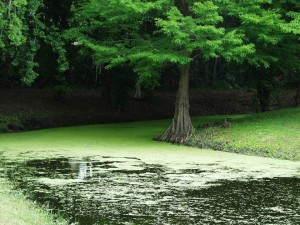
A body of water receiving excess nutrients can turn green and unhealthy from too much algae growth. Photo Credit: UF IFAS FFL program
The new legislation encourages professional lawn care staff to take a day-long course covering these concepts, and additional topics such as irrigation, pest management, and proper landscaping practices. The course, offered online and in every UF IFAS Extension office, prepares the audience for the test and certification, and gives useful tips and information for their everyday work.
Several counties, most recently Escambia, have passed local ordinances echoing the requirement to have this license when seeking a business tax certification to operate a lawn care service (providing fertilizer) in the county. In addition, local ordinances typically have a “prohibited application period,” which may involve a particular time of the year or weather condition. The ordinances also restrict blowing or sweeping lawn debris into storm drains, which can cause the same water quality problems as excess fertilizer. Visit the GI-BMP website to learn more about the program, and if you, friends, or neighbors use a professional lawn care service to fertilize your lawn, be sure to ask for proof of their fertilizer license.
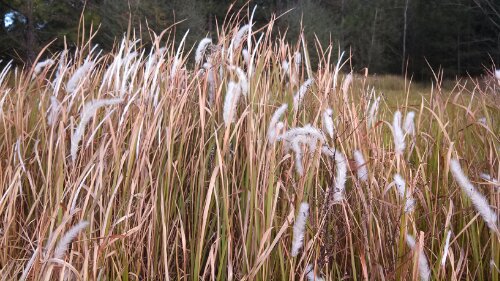
by Jennifer Bearden | Jan 3, 2014

Join us for a workshop on the biology and control of cogongrass.
January 14, 2014
Registration begins at 8:30am (Eastern Time)
Program starts at 9:00am (Eastern Time) and will end at 4:30pm (Eastern Time).
The cost of the workshop is $25 and includes lunch.
Locations:
Pensacola, Fl
Crestview, Fl
Chipley, Fl
Tallahassee, Fl

Please remember to specify which locations when calling to register and purchase the correct location ticket when registering online.
Pesticide CEUs have been requested. We are awaiting final approval and will update this post as soon as we have additional information. If you have questions please contact us at 850-606-5200.
AGENDA
Cogongrass in the Panhandle Workshop
9:00 – 9:50 AM – Overview, Biology and Control of Cogongrass – Dr Greg MacDonald, UF-IFAS Agronomy – Participants will learn what we currently know about the biology and control of cogongrass.
9:50 – 10:40 AM – “Safely Applying Right of Way Herbicides” – Jennifer Bearden & Sheila Dunning, UF-IFAS Extension Okaloosa County – Participants will learn pathways of herbicide efficacy, safety, label-reading, and PPE for common Right of Way Herbicides.
11:00-11:50 AM – Update: “Cogongrass Control in ROW, Forestry and Natural Areas – New Research, New Programs” – Participants will learn herbicide selections, application rates, timing and methods of control being researched and employed in the Southeast.
11:00 – 11:25 AM – “Imazapyr and Glyphosate Application Rate, Timing, and Methods for Cogongrass Control” – Dr Pat Minogue, UF-IFAS/NFREC Forestry
11:25 – 11:50 AM – “USFS/Five-State Forestry Agency Cogongrass Initiative” – Dr Jeff Eickwort, FDACS-Florida Forest Service
11:50 AM – 12:40 PM – “Cooperative Invasive Species Management in the Panhandle”
11:50 – 12:10 – “Breaking down Artificial Barriers to Allow Everyone to Cooperate” –
Brian Pelc, Natural Areas Restoration Specialist with The Nature Conservancy, and Invasive Species Coordinator for the Apalachicola National Forest, USFS
12:10 – 12:25 – A Regional Case Study from the Apalachicola CISMA (Cooperative Invasive Species Management Area) – Brian Pelc, Natural Areas Restoration Specialist with The Nature Conservancy and Invasive Species Coordinator for the Apalachicola National Forest, USFS
12:25 – 12:40 – A Regional Case Study from the Six Rivers CISMA – Brooke Saari, Sea Grant Extension Agent, UF/IFAS Extension in Okaloosa and Walton counties
12:40 – 1:30 PM – Lunch (catered-in at each host site)
1:30 – 2:30 PM – “Tools for Identifying, Tracking and Managing Cogongrass across the Landscape” – Participants will learn to use technologies available to identify, track and manage cogongrass infestations.
1:30 – 2:00 PM – “Monitoring Cogongrass Infestations with EDDMapS” – Jed Dillard, UFIFAS Extension Jefferson County
2:00 – 2:30 PM – “A Local Case Study from the City of Tallahassee”– Tony Murray, Coordinator of Environmental Regulation Compliance with City of Tallahassee Environmental Policy and Energy Resources/ Policy & Program Development
The following topics will be covered by Extension faculty at each site.
Okaloosa – Jennifer Bearden and Sheila Dunning
Washington – Mark Mauldin and Josh Thompson
Leon – Will Sheftall and Stan Rosenthal
Jefferson – Jed Dillard
2:30 – 2:55 PM – Cogongrass and Look-alikes ID – Participants will learn how to identify Cogongrass and some similar plants.
3:00 – 3:25 PM – Label Reading Exercise – Participants will learn to read herbicide labels and why it is important.
3:30 – 3:55 PM – Sprayer Calibration – Participants will learn methods to calibrate ATV and Backpack sprayer equipment.
4:00 – 4:25 PM – Personal Protective Equipment – Participants will learn proper equipment and why it is important.
4:25-4:30 PM – Evaluation


















